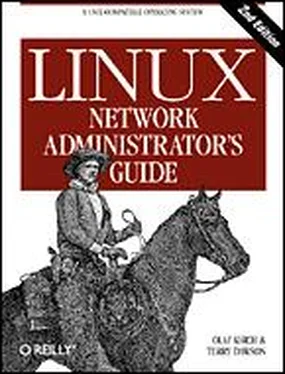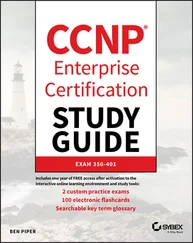The very first interface to be activated is the loopback interface:
# ifconfig lo 127.0.0.1
Occasionally, you will see the dummy hostname localhost being used instead of the IP address. ifconfig will look up the name in the hosts file, where an entry should declare it as the hostname for 127.0.0.1 :
# Sample /etc/hosts entry for localhost
localhost 127.0.0.1
To view the configuration of an interface, you invoke ifconfig, giving it only the interface name as argument:
$ ifconfig lo
lo Link encap:Local Loopback
inet addr:127.0.0.1 Mask:255.0.0.0
UP LOOPBACK RUNNING MTU:3924 Metric:1
RX packets:0 errors:0 dropped:0 overruns:0 frame:0
TX packets:0 errors:0 dropped:0 overruns:0 carrier:0
Collisions:0
As you can see, the loopback interface has been assigned a netmask of 255.0.0.0 , since 127.0.0.1 is a class A address.
Now you can almost start playing with your mini-network. What is still missing is an entry in the routing table that tells IP that it may use this interface as a route to destination 127.0.0.1 . This is accomplished by using:
# route add 127.0.0.1
Again, you can use localhost instead of the IP address, provided you've entered it into your /etc/hosts .
Next, you should check that everything works fine, for example by using ping. ping is the networking equivalent of a sonar device. [31] Anyone remember Pink Floyd's "Echoes"?
The command is used to verify that a given address is actually reachable, and to measure the delay that occurs when sending a datagram to it and back again. The time required for this process is often referred to as the "round-trip time":
# ping localhost
PING localhost (127.0.0.1): 56 data bytes
64 bytes from 127.0.0.1: icmp_seq=0 ttl=255 time=0.4 ms
64 bytes from 127.0.0.1: icmp_seq=1 ttl=255 time=0.4 ms
64 bytes from 127.0.0.1: icmp_seq=2 ttl=255 time=0.4 ms
^C
-- localhost ping statistics -- 3 packets transmitted, 3 packets received, 0% packet loss
round-trip min/avg/max = 0.4/0.4/0.4 ms
#
When you invoke ping as shown here, it will continue emitting packets forever, unless interrupted by the user. The ^C marks the place where we pressed Ctrl-C.
The previous example shows that packets for 127.0.0.1 are properly delivered and a reply is returned to ping almost instantaneously. This shows that you have successfully set up your first network interface.
If the output you get from ping does not resemble that shown in the previous example, you are in trouble. Check any errors if they indicate that some file hasn't been installed properly. Check that the ifconfig and route binaries you use are compatible with the kernel release you run, and above all, that the kernel has been compiled with networking enabled (you see this from the presence of the /proc/net directory). If you get an error message saying "Network unreachable," you probably got the route command wrong. Make sure you use the same address you gave to ifconfig.
The steps previously described are enough to use networking applications on a standalone host. After adding the lines mentioned earlier to your network initialization script and making sure it will be executed at boot time, you may reboot your machine and try out various applications. For instance, telnet localhost should establish a telnet connection to your host, giving you a login: prompt.
However, the loopback interface is useful not only as an example in networking books, or as a test bed during development, but is actually used by some applications during normal operation. [32] For example, all applications based on RPC use the loopback interface to register themselves with the portmapper daemon at startup. These applications include NIS and NFS.
Therefore, you always have to configure it, regardless of whether your machine is attached to a network or not.
Configuring an Ethernet interface is pretty much the same as the loopback interface; it just requires a few more parameters when you are using subnetting.
At the Virtual Brewery, we have subnetted the IP network, which was originally a class B network, into class C subnetworks. To make the interface recognize this, the ifconfig incantation would look like this:
# ifconfig eth0 vstout netmask 255.255.255.0
This command assigns the eth0 interface the IP address of vstout ( 172.16.1.2 ). If we omitted the netmask, ifconfig would deduce the netmask from the IP network class, which would result in an incorrect netmask of 255.255.0.0 . Now a quick check shows:
# ifconfig eth0
eth0 Link encap 10Mps Ethernet HWaddr 00:00:C0:90:B3:42
inet addr 172.16.1.2 Bcast 172.16.1.255 Mask 255.255.255.0
UP BROADCAST RUNNING MTU 1500 Metric 1
RX packets 0 errors 0 dropped 0 overrun 0
TX packets 0 errors 0 dropped 0 overrun 0
You can see that ifconfig automatically sets the broadcast address (the Bcast field) to the usual value, which is the host's network number with all the host bits set. Also, the maximum transmission unit (the maximum size of IP datagrams the kernel will generate for this interface) has been set to the maximum size of Ethernet packets: 1,500 bytes. The defaults are usually what you will use, but all these values can be overidden if required, with special options that will be described under "All About ifconfig".
Just as for the loopback interface, you now have to install a routing entry that informs the kernel about the network that can be reached through eth0 . For the Virtual Brewery, you might invoke route as:
# route add -net 172.16.1.0
At first this looks a little like magic, because it's not really clear how route detects which interface to route through. However, the trick is rather simple: the kernel checks all interfaces that have been configured so far and compares the destination address ( 172.16.1.0 in this case) to the network part of the interface address (that is, the bitwise AND of the interface address and the netmask). The only interface that matches is eth0 .
Now, what's that -net option for? This is used because route can handle both routes to networks and routes to single hosts (as you saw before with localhost ). When given an address in dotted quad notation, route attempts to guess whether it is a network or a hostname by looking at the host part bits. If the address's host part is zero, route assumes it denotes a network; otherwise, route takes it as a host address. Therefore, route would think that 172.16.1.0 is a host address rather than a network number, because it cannot know that we use subnetting. We have to tell route explicitly that it denotes a network, so we give it the -net flag.
Of course, the route command is a little tedious to type, and it's prone to spelling mistakes. A more convenient approach is to use the network names we defined in /etc/networks . This approach makes the command much more readable; even the -net flag can be omitted because route knows that 172.16.1.0 denotes a network:
Читать дальше



![Andrew Radford - Linguistics An Introduction [Second Edition]](/books/397851/andrew-radford-linguistics-an-introduction-second-thumb.webp)








